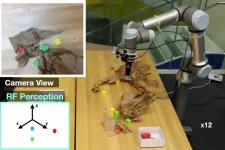(Press-News.org) The humble lab mouse has provided invaluable clues to understanding diseases ranging from cancer to diabetes to COVID-19. But when it comes to psychiatric conditions, the lab mouse has been sidelined, its rodent mind considered too different from that of humans to provide much insight into mental illness.
A new study, however, shows there are important links between human and mouse minds in how they function -- and malfunction. Researchers at Washington University School of Medicine in St. Louis devised a rigorous approach to study how hallucinations are produced in the brain, providing a promising entry point to the development of much-needed new therapies for schizophrenia.
The study, published April 2 in the journal Science, lays out a way to probe the biological roots of a defining symptom of psychosis: hallucinations. The researchers trained people and mice to complete a computer-based task that induced them to hear imaginary sounds. By analyzing performance of the task, the researchers were able to objectively measure hallucination-like events in people and mice. This innovative approach allowed them to study the neural circuits underlying hallucinations, opening up mental symptoms to the kind of scientific studies that have been so fruitful for diseases of other parts of the body.
"It's so easy to accept the argument that psychosis is a fundamentally human thing and say, 'Forget about mice'," said senior author Adam Kepecs, PhD, a professor of neuroscience and of psychiatry, and a BJC Investigator at the School of Medicine. "But right now, we're failing people with serious psychiatric conditions. The prognosis for psychotic patients has not substantially improved over the past decades, and that's because we don't really understand the neurobiology of the disease. Animal models have driven advances in every other field of biomedicine. We're not going to make progress in treating psychiatric illnesses until we have a good way to model them in animals."
Psychosis occurs when a person loses touch with reality. During a psychotic episode, people may acquire false beliefs (delusions) or confidently believe that they are seeing or hearing things that are not occurring (hallucinations). A psychotic episode can be a sign of a serious mental illness such as schizophrenia or bipolar disorder, but people without mental illness also can experience symptoms such as hallucinations.
To study how hallucinations occur, Kepecs -- with first author Katharina Schmack, MD, PhD, of Cold Spring Harbor Laboratory, and colleagues -- set up a computer game that could be completed by both people and mice. The researchers played a particular sound, and subjects indicated that they'd heard it by clicking a button (people) or poking their noses into a port (mice). The task was made challenging by obscuring the sound with background noise. People in the study rated how confident they felt that they'd accurately identified a real sound by moving a slider on a scale; mice indicated their confidence by how long they waited for a reward. When a subject confidently reported that he or she had heard a sound that was not actually played, the researchers labeled that a hallucination-like event.
While simple in design, the task appeared to tap into the brain circuits underlying hallucinations. People with more hallucination-like events during the experiment also were more likely to experience spontaneous hallucinations -- as measured by questionnaires designed to evaluate psychiatric symptoms in the general population -- even though no participants were diagnosed with a psychiatric condition.
People's beliefs and expectations can prime them to experience hallucinations. Expecting to hear a certain word makes it more likely that people actually report that they have heard it, even when it wasn't spoken. In fact, previous studies have shown that people who are prone to hallucinations are particularly susceptible to this kind of priming.
"Human speech is very difficult to comprehend in a noisy environment," Kepecs said. "We are always balancing our prior knowledge of human speech against what we're hearing in the moment to understand spoken language. You can easily imagine that this system can get imbalanced, and all of a sudden you're hearing things."
To test whether mice also can be primed the same way, Kepecs and colleagues manipulated the mice's expectations by adjusting how frequently the sound was played. When the sound was played frequently, the mice were even more likely to confidently but wrongly report that they'd heard it - similar to people.
To better connect mouse and human experience, the researchers also used a drug that induces hallucinations. Ketamine can induce distortions in perceptions of sight and sound and can trigger psychotic episodes in healthy people. Mice that were given ketamine before performing the task also reported more hallucination-like events.
Having established these crucial similarities between mice and people, the researchers then investigated the biological roots of hallucinations. By studying mice, they could make use of an arsenal of technologies for monitoring and controlling brain circuits to figure out what happens during hallucination-like events.
The brain chemical dopamine has long been known to play a role in hallucinations. People experiencing hallucinations can be treated with antipsychotic medications that block dopamine. But how dopamine changes brain circuits to produce hallucinations has remained unknown.
When studying mice, the researchers observed that elevations in dopamine levels preceded hallucination-like events and that artificially boosting dopamine levels induced more hallucination-like events. These behavioral effects could be blocked by administering the antipsychotic drug haloperidol, which blocks dopamine.
"There seems to be a neural circuit in the brain that balances prior beliefs and evidence, and the higher the baseline level of dopamine, the more you rely on your prior beliefs," Kepecs said. "We think that hallucinations occur when this neural circuit gets unbalanced, and antipsychotics rebalance it. Our computer game probably engages this same circuit, so hallucination-like events reflect this circuit imbalance. We are very excited about this computational approach to study hallucinations across species that enables us to finally probe the neurobiological roots of this mysterious experience."
INFORMATION:
Tropical rainforests today are biodiversity hotspots and play an important role in the world's climate systems. A new study published today in Science sheds light on the origins of modern rainforests and may help scientists understand how rainforests will respond to a rapidly changing climate in the future.
The study led by researchers at the Smithsonian Tropical Research Institute (STRI) shows that the asteroid impact that ended the reign of dinosaurs 66 million years ago also caused 45% of plants in what is now Colombia to go extinct, and it made way for the reign of flowering plants in modern tropical rainforests.
"We wondered how tropical rainforests changed after a drastic ecological perturbation such as the Chicxulub impact, so we looked for tropical plant fossils," said Mónica ...
LA JOLLA--(April 1, 2021) Neurons lack the ability to replicate their DNA, so they're constantly working to repair damage to their genome. Now, a new study by Salk scientists finds that these repairs are not random, but instead focus on protecting certain genetic "hot spots" that appear to play a critical role in neural identity and function.
The findings, published in the April 2, 2021, issue of Science, give novel insights into the genetic structures involved in aging and neurodegeneration, and could point to the development of potential new therapies for diseases such Alzheimer's, Parkinson's and other age-related dementia disorders.
"This research shows for the first time that ...
On the afternoon of April 13, 2018, a large wave of water surged across Lake Michigan and flooded the shores of the picturesque beach town of Ludington, Michigan, damaging homes and boat docks, and flooding intake pipes. Thanks to a local citizen's photos and other data, NOAA scientists reconstructed the event in models and determined this was the first ever documented meteotsunami in the Great Lakes caused by an atmospheric inertia-gravity wave.
An atmospheric inertia-gravity wave is a wave of air that can run from 6 to 60 miles long that is created when a mass of stable air is displaced by an air mass with significantly ...
In recent years, robots have gained artificial vision, touch, and even smell. "Researchers have been giving robots human-like perception," says MIT Associate Professor Fadel Adib. In a new paper, Adib's team is pushing the technology a step further. "We're trying to give robots superhuman perception," he says.
The researchers have developed a robot that uses radio waves, which can pass through walls, to sense occluded objects. The robot, called RF-Grasp, combines this powerful sensing with more traditional computer vision to locate and grasp items that might otherwise be blocked from view. The advance could one day streamline e-commerce fulfillment in warehouses or help a machine pluck a screwdriver from a jumbled toolkit.
The research will be presented in May at the IEEE International ...
Plant inducible defense starts with the recognition of microbes, which leads to the activation of a complex set of cellular responses. There are many ways to recognize a microbe, and recognition of microbial features by pattern recognition receptors (PRRs) outside the cell was long thought to activate the first line of defense: Pattern Triggered Immunity, or PTI. To avoid these defense responses, microbes of all kinds evolved the ability to deliver effector molecules to the plant cell, either directly into the cytoplasm or into the area just outside the cell, where they are taken up into the cytoplasm. ...
New research published today in the journal Blood Advances is the first to show that restricting calories, reducing fat and sugar intake, and increasing physical activity may boost the effectiveness of chemotherapy for older children and adolescents with leukemia. This intervention, which improved chemotherapy outcomes for children being treated at two institutions, will be further studied through a national trial later this year.
B-cell acute lymphoblastic leukemia (B-ALL), a cancer affecting the white blood cells in the bone marrow, is the most common type of cancer in children. In the study, researchers assessed the effects of diet and exercise on 40 individuals aged 10-21 undergoing chemotherapy at ...
In some cancers, including leukemia in children and adolescents, obesity can negatively affect survival outcomes. Obese young people with leukemia are 50% more likely to relapse after treatment than their lean counterparts.
Now, a study led by researchers at UCLA and Children's Hospital Los Angeles has shown that a combination of modest dietary changes and exercise can dramatically improve survival outcomes for those with acute lymphoblastic leukemia, the most common childhood cancer.
The researchers found that patients who reduced their calorie intake by 10% or more and adopted a moderate exercise program immediately after their diagnosis had, on average, 70% less ...
For years, research to pin down the underlying cause of Alzheimer's Disease has been focused on plaque found to be building up in the brain in AD patients. But treatments targeted at breaking down that buildup have been ineffective in restoring cognitive function, suggesting that the buildup may be a side effect of AD and not the cause itself.
A new study led by a team of Brigham Young University researchers finds novel cellular-level support for an alternate theory that is growing in strength: Alzheimer's could actually be a result of metabolic dysfunction in the brain. In other words, there is growing evidence that diet and lifestyle are at the ...
Los Angeles (April 1, 2021) -- Overweight children and adolescents receiving chemotherapy for treatment of leukemia are less successful battling the disease compared to their lean peers. Now, research conducted at the END ...
Buildings are responsible for 40 percent of primary energy consumption and 36 percent of total CO2 emissions. And, as we know, CO2 emissions trigger global warming, sea level rise, and profound changes in ocean ecosystems. Substituting the inefficient glazing areas of buildings with energy efficient smart glazing windows has great potential to decrease energy consumption for lighting and temperature control.
Harmut Hillmer et al. of the University of Kassel in Germany demonstrate that potential in "MOEMS micromirror arrays in smart windows for daylight steering," a paper published recently in the inaugural issue of the Journal of Optical Microsystems.
"Our smart glazing ...





